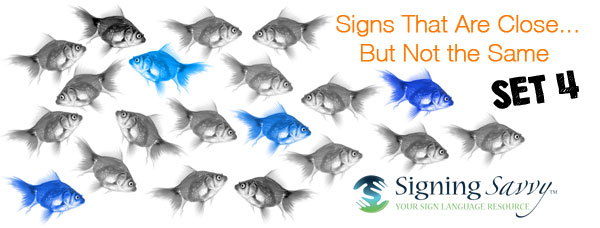
Signs That Are Close... But Not the Same - Set 4
This article is part of our “Signs That Are Close... But Not the Same” series, which highlights signs that look similar, but have different meanings.
The ASL signs shown below look similar, but are not the same. There are many ASL signs that when produced look similar, but in fact have a completely different meaning. Below you will find examples of such signs. Watch closely to see if you can see the differences. In addition, watch my eyebrows, look to see when I tilt my head or lean my body in a certain way, even what my mouth is doing. These nuances are called inflections and trust me, inflections matter.
1. Open vs. Close
OPEN and CLOSE is another pair of signs that look similar but are easy to remember. The hands mimic opening or closing something. These signs are used when talking about items that would open or close in this fashion, like a box. If you are talking about opening or closing a book or window or door, the signs used would be different to more closely gesture the movements made when opening or closing those things.
 |
2. Love vs. Hug
Don’t blink or you might miss the subtle difference between LOVE and HUG! Luckily the context in which the signs are used can often help as well. To sign LOVE both arms are crossed and drawn to the chest like something is being held close to the heart because it is loved. HUG is similar to signing LOVE and is like the motion of giving a hug, but has two movements.
 |
3. Ice skate vs. Roller skate
The same motion is used when signing ICE SKATE and ROLLER SKATE, but X-hands are used when signing ICE SKATE and bent V-hands are used when signing ROLLER SKATE. To remember this slight difference in handshape, think about your hands representing the moving skates and X-hands with one finger out on each hand are like the single blade of an ice skate, while bent V-hands with two bent fingers out on each hand are like the two front wheels of roller skates.
 |
4. Black vs. Summer
BLACK and SUMMER both have the dominant index finger come across the forehead, but there are some subtle differences that are easy to spot when you know to look for them. The handshape of SUMMER transforms from the index finger to an X-hand, while the index finder is used the whole time when signing BLACK. Additionally, the palm orientation is slightly different between these two signs. The palm is facing slightly out from the body when signing SUMMER, while it is facing more in towards the body when signing BLACK - the distinction of palm orientation between these two signs is most obvious at the end of the signs.
 |
5. Can vs. Possible
When signing CAN and POSSIBLE both A-hands move downward at the same time. There are two movements when signing POSSIBLE and one movement when signing CAN (because you are sure - you CAN! Also the stronger the single movement is, the more you are indicating you are confident that you CAN).
 |
How can I figure out the difference between signs on my own?
If you see two signs that look close, but not the same, and you’re not sure, you may use Signing Savvy features to help you figure out the difference. All of our signs have sign descriptions and memory aids that members may access. Reading the sign description and memory aids for the signs will help you figure out the small differences between them that your eyes don’t catch at first. We also recommend using the pause and slow motion feature to slow down the video, so you may take a closer look. These features are available to Signing Savvy members.
Take a look, it's in a book!
These examples are aligned with the Visual Discrimination section of Lesson 5 (page 60) from Lessons and Activities in American Sign Language by Brenda E. Cartwright and Suellen J. Bahleda. Check out the book for more ASL Activities and watch for more examples from this series: “Signs That Are Close... But Not the Same.”
Resources
Signing Savvy is a participant in the Amazon Services LLC Associates Program, an affiliate advertising program designed to provide a means for sites to earn advertising fees by advertising and linking signingsavvy.com to Amazon properties. That means Signing Savvy may contain affiliate links. If you make a purchase after clicking on an affiliate link, your cost will be exactly the same regardless, but Signing Savvy will automatically receive a small commission. Your support is greatly appreciated and helps us continue to improve Signing Savvy!
ADVERTISEMENTS
 Brenda Cartwright is a Coda, seasoned interpreter, a master teacher, well known presenter, and author of several best selling sign language and interpreting textbooks from the RID Press. For 35 years Brenda was the Chair of the Sign Language Interpreter Program at Lansing Community College in Lansing, Michigan.
Brenda Cartwright is a Coda, seasoned interpreter, a master teacher, well known presenter, and author of several best selling sign language and interpreting textbooks from the RID Press. For 35 years Brenda was the Chair of the Sign Language Interpreter Program at Lansing Community College in Lansing, Michigan. Signs That Are Close... But Not the Same - Set 1
Signs That Are Close... But Not the Same - Set 1 Signs That Are Close... But Not the Same - Set 2
Signs That Are Close... But Not the Same - Set 2 Signs That Are Close... But Not the Same - Set 3
Signs That Are Close... But Not the Same - Set 3 Signs That Are Close... But Not the Same - Set 5
Signs That Are Close... But Not the Same - Set 5 Signs That Are Close... But Not the Same - Set 6
Signs That Are Close... But Not the Same - Set 6








Savvy User LoriSaturday, February 18, 2017
It looks like a correction needs to be made in the explanation of the signs:
"The handshape of SUMMER transforms from the index finger to an x-hand, while the index finger is used the whole time when signing SUMMER."
Should read:
"The handshape of SUMMER transforms from the index finger to an x-hand, while the index finger is used the whole time when signing BLACK."
Nice column, otherwise